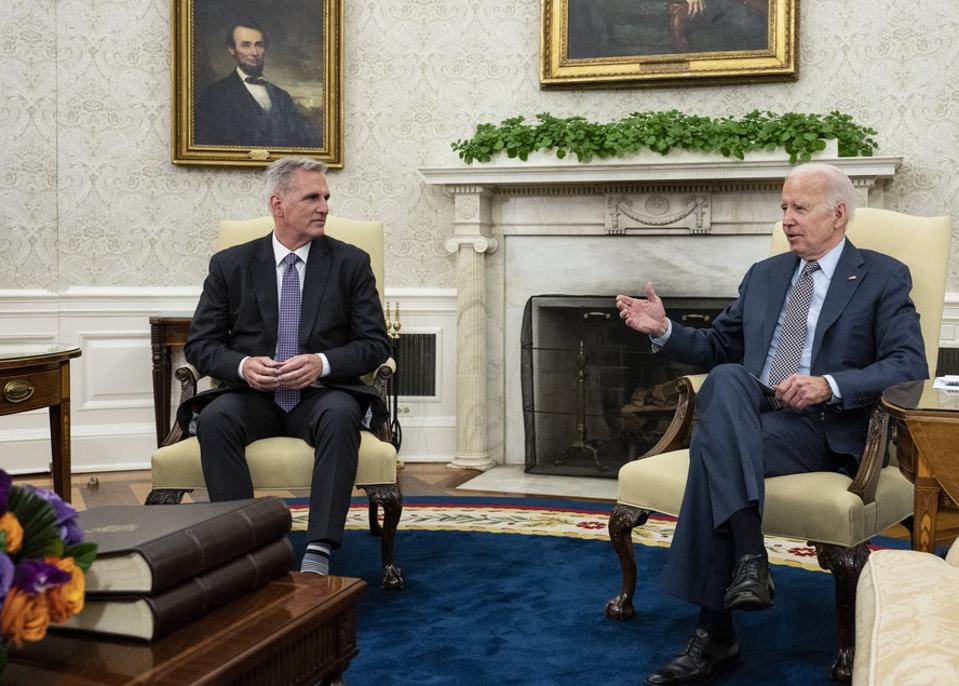The agreement, which raises the debt ceiling for two years, still needs congressional approval.

President Joe Biden and House Speaker Kevin McCarthy (R-Calif.) reached an “agreement in principle” Saturday to raise the debt ceiling.
Drew Angerer/Getty
President Joe Biden and House Speaker Kevin McCarthy (R-Calif.) reached an “agreement in principle” Saturday after months of negotiations among policymakers to raise the debt ceiling and prevent the country from defaulting on its loans for the first time, but now leaders on both sides of the aisle will have to sell the deal to their parties before the June 5 government default.
Key Takeaways
- Biden and McCarthy reportedly spent 90 minutes on the phone Saturday night to finish ironing out the details of the tentative agreement with just days to go before the U.S. potentially ran out of money to pay its bills.
- The deal focuses on a few core areas: keeping spending flat for fiscal year 2024 and increase it by 1% for 2025, raising the age for work requirements for government aid such as SNAP benefits, fully funded medical care for veterans, a compromise on the federal permitting process, and the withdrawal of unused Covid-19 relief funds from past Congressional bills.
- Republicans were unable to use the debt ceiling to force Biden to cancel his student debt relief plan—canceling up to $20,000 of student loan debt for millions of Americans—but an unnamed source told Politico the agreement codifies the administration plan to end the pause on student loan payments and interests at the end of the summer, about a month earlier than the Education Department’s planned payment restart of September.
- News of the deal was quickly met with disappointment and anger from some conservative Congress members, Rep. Ralph Norman (R-S.C.) described the deal as “insanity,” adding that he’s “not gonna vote to bankrupt our country,” meanwhile Rep. Chip Roy (R-Texas) described the deal as “turd-sandwich” and said he knows of other members who do not support the bill.
- Biden and McCarthy are reportedly set to meet again Sunday at 2:00 pm, with the text of the deal expected shortly after; the Biden administration is set to brief Democrats Sunday evening.
- Biden and McCarthy will have to rally enough support from their parties to overcome factions — some progressives on the left and some conservatives on right — who wanted to more extreme concessions from the other side and could vote against the bill, which will need to be passed within a week before the projected June 5 government default.
What To Watch For
McCarthy and Biden have limited time to gather support from their respective parties. Lawmakers are expected to return from the holiday weekend on Tuesday at the earliest, at which point Congress will have less than a week to pass the bill before the projected June 5 government default.
McCarthy said he would post the bill 72 hours before a vote, providing even less time for leadership to get their respective party’s on board.
Key Background
For months the White House and Republican congressional leaders have been at odds on how to raise the $31.4 trillion federal debt ceiling. The Biden Administration said it would not agree to a debt ceiling bill that had other conditions attached, while Republicans wanted broad spending cuts in exchange for raising the debt ceiling.
Amid the tense negotiations in Washington, Treasury Secretary Janet Yellen had been cautioning for weeks just how catastrophic a default could be for the country. On Friday she issued a stark warning saying inaction by June 5 would “cause severe hardship to American families, harm our global leadership position and raise questions about our ability to defend our national security interests.”
This story was first published on forbes.com and all figures are in USD.
Forbes Australia issue no.4 is out now. Tap here to secure your copy or become a member here.
Look back on the week that was with hand-picked articles from Australia and around the world. Sign up to the Forbes Australia newsletter here.

